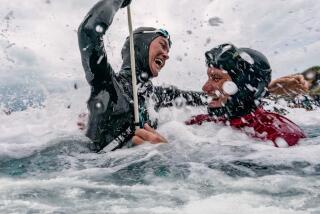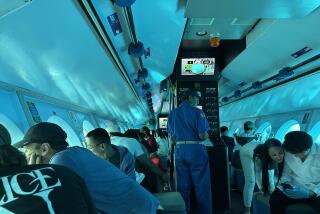Swimmers Can Journey to Florida’s Inner Space
- Share via
KEY LARGO, Fla. — Through the large circular window we watched tiny fish and bioluminescent plankton drift past while eating dinner in the cozy room 30 feet beneath the sea. Our stay in this extraordinary underwater hotel was a strange and awesome journey to inner space.
Jules’ Undersea Lodge is a new facility, constructed inside the shell of what was the La Chalupa sea lab in Puerto Rico. The austere interior of the sea lab habitat has been converted into luxurious guest quarters, complete with a compact microwave kitchen, TV monitors with VCRs, stereos, telephones, a two-way radio, a chemical toilet and a hot shower.
A continuous flow of fresh, clean air is pumped into the lab at a constant temperature and there are automatic backup air and electrical systems in case of a power failure. A closed-circuit TV camera monitors the “wet room” between the two living chambers.
The cost of $600 a night for two is high. However, we came to appreciate the unusual logistics of running a hotel underwater. Maid service must be performed by a mermaid or merman who is a certified scuba diver.
All personal belongings, including clothes, toilet articles and cameras, must be carried down to the hotel in waterproof containers known as Pelican cases, which have O-ring seals. Meals, linens and other supplies must be transported in the same manner.
Aquanaut Orientation
It takes more than 2 1/2 hours of briefing and aquanaut orientation just to check into the hotel. All guests must be certified divers or take a special scuba training course in the area before their stay at the lodge. A resort training course can usually be accomplished in half a day for about $90.
On our dive to reach Jules’ Undersea Lodge the clarity of the water was not outstanding. The general manager, Jim Maddox, explained that the mangrove lagoon had just undergone an algae bloom from changes in salinity and temperature.
That, combined with the natural sediment, reduced visibility to about 10 feet. Visibility normally ranges between 30 and 60 feet, but diving enthusiasts should be aware that even under the best conditions this is not “The Blue Lagoon.”
After we had been fitted with short wet suits and weight belts, Maddox took us out to the staging platform (raft) for our dive to the lodge. Instead of scuba tanks, our air was supplied with long hookah air hoses and regulators.
We entered the water and immediately were in a strange, quiet world of soft green light. Sediment drifted past our face masks, air bubbles trailed up like tiny pearls and our flippers propelled us down to the shadowy forms below.
Beneath us was the ghostly bow of a sunken boat that pointed directly toward the lodge. We swam a short distance and suddenly the dark form of the lodge loomed over us.
Sharp Contrast
One enters the facility from the underside, the open port acting on the same principle as an inverted glass pushed down into a container of water. Air is trapped in the glass and the water cannot rise.
Going through the port singly, we emerged into a brightly lit tile room, a sharp contrast to the murky water we had just left. There were neat racks to hang up our wet suits and hookah regulators. The hot shower was a welcome luxury.
Three ports form entry doors into the living chambers and after toweling ourselves dry we climbed through one on the left side leading to the kitchen and common living room. The difference in the humidity was noticeable immediately. The living area is comfortably dry, with a perfect temperature near 72 degrees.
The interior walls and floors are covered with carpeting, and a large port looks into the green world outside. Maddox showed us through the lodge and then left, promising to return later for a brief visit with his 9-year-old son, Michael.
In about 10 minutes the radio crackled and Jim cheerfully announced that he and Michael would be joining us again at 4:30. He also said that they would swim past the port of the common living room to give us a chance to take pictures.
Almost precisely on the minute, father and son appeared in the window, waving and feeding the hungry little fish around them. A few minutes later they joined us in the living room.
Michael is among the youngest aquanauts in the world. He lives a glamorous, adventurous life with his father aboard their 36-foot sailboat, which is tied up in the lagoon. Like any fourth-grader, he catches the school bus every weekday morning.
Easygoing Humor
His father is a former naval diver, certified as a medical deep-sea diving technician. Equally important is Jim’s easygoing good humor and assurance, which inspires confidence in hotel guests.
It was then that we were suddenly aware of being alone . . . in alien surroundings. The sound of the air bubbling through the port was disquieting and the sense of isolation intense. If we had not been together, it could have been overwhelming. It was comforting to share the experience.
We entertained ourselves by feeding small pieces of Canadian bacon to a hungry horde of mangrove snappers that had clustered around the port.
Some guests at the lodge often go out for night dives, using the hookah regulators and portable underwater lights. But because of the limited visibility and because the water was a bit chilly, we chose not to.
Instead we settled into the living room and watched “20,000 Leagues Under the Sea” on the VCR.
Our dinner was in the refrigerator--plump lobster, asparagus, potatoes, fresh salad and Key Lime pie. We popped the cookables into the microwave and a few minutes later sat down to a feast worthy of Neptune.
Night had come to the lagoon, and the nocturnal marine creatures glistened just outside the circular port, their curious eyes looking in on a world they probably could not comprehend. The excitement of the day caught up with us, and in no time we were asleep, dreaming of sea gods and mermaids.
Safety Measure
The application form for reservations states that you should allow 12 hours on the surface--after your stay in the lodge--before taking any airline flights. Some nitrogen is absorbed into the blood when a person breathes air under pressure, and divers working at great depth must decompress, coming to the surface very slowly.
Thirty feet is not very deep, but even at that depth, nitrogen bubbles could form later in your bloodstream at high altitudes and give you “the bends” if you fly too soon.
Smoking and alcohol are not permitted in the lodge. It’s also suggested that hair spray, deodorants and perfumes in aerosol cans not be used because they can contaminate the air.
Returning to shore the next morning, we talked to Gary Gerberg, president of Jules’ Habitat Inc., one of the owners and developers of Jules’ Undersea Lodge. We learned that there had been about 75 guests in the lodge since it opened Dec. 1. Plans are being developed for a larger and more elaborate underwater habitat on Grand Cayman Island. That one will have a submarine to transport guests and their belongings to and from the hotel.
You can write for literature about the lodge to Jules’ Undersea Lodge, P.O. Box 756, Key Largo, Fla. 33037 or phone (305) 451-2353. Reservations are necessary.
We suggest combining a stay in the underwater hotel with additional reef dives at nearby John Pennekamp Coral Reef State Park, which has living coral reefs with a rich variety of marine life and usually clear water.
Information and brochures on that and other attractions in the Florida Keys is available by calling toll-free (800) FLA-KEYS.
More to Read
Sign up for The Wild
We’ll help you find the best places to hike, bike and run, as well as the perfect silent spots for meditation and yoga.
You may occasionally receive promotional content from the Los Angeles Times.






